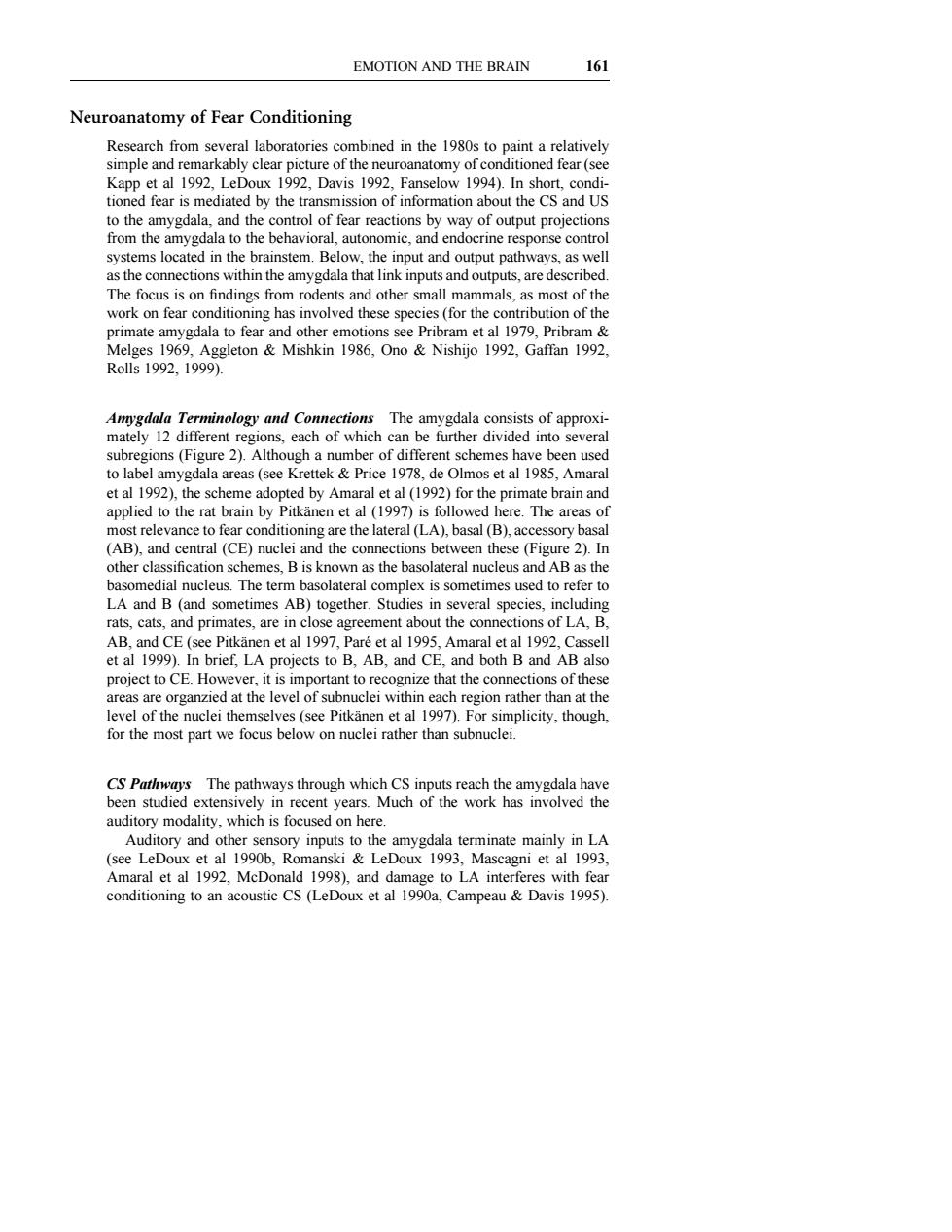正在加载图片...

EMOTION AND THE BRAIN 161 Neuroanatomy of Fear Conditioning tioned fear is mediated by the transmission of information about the CS and US to the amygdala,and the control of fear reactions by way of output projections from the o the behavio autonomic,and esponse contro as the connections within the amvgdala that link inputs and outputs ae described The focus is on findings from rodents and other small mammals,as most of the Rol1s199219991 ely 12 ent n c no severa to label amygdala areas (see Krettek&Price 1978.de Olmos etal 1985.Amaral et al 1992),the scheme adopted by Amaral et al(1992)for the primate brain and applied to the rat rain by Pitkanen et a1997)1s1o ere.The areas o ),a other classification schemes b is known as the basolateral nucleus and ab as the (an AB.and CE (see Pitkanen et al 997.Pare et al 1995.Amaral et al 1992.Cassell et al 1999).In brief,LA projects to B.AB,and CE.and both B and AB also project to CE.However. is important to recognize th at the connections of the l1997 a s (see pitka for the most part we focus below on nuclei rather than subnuclei c Much involved the Auditory and other sensory inputs to the amygdala terminate mainly in LA (see LeDoux et al 1990b,Romanski&LeDoux 1993,Mascagni et al 1993. 1992 LA inte ampeau EMOTION AND THE BRAIN 161 Neuroanatomy of Fear Conditioning Research from several laboratories combined in the 1980s to paint a relatively simple and remarkably clear picture of the neuroanatomy of conditioned fear (see Kapp et al 1992, LeDoux 1992, Davis 1992, Fanselow 1994). In short, conditioned fear is mediated by the transmission of information about the CS and US to the amygdala, and the control of fear reactions by way of output projections from the amygdala to the behavioral, autonomic, and endocrine response control systems located in the brainstem. Below, the input and output pathways, as well as the connections within the amygdala that link inputs and outputs, are described. The focus is on findings from rodents and other small mammals, as most of the work on fear conditioning has involved these species (for the contribution of the primate amygdala to fear and other emotions see Pribram et al 1979, Pribram & Melges 1969, Aggleton & Mishkin 1986, Ono & Nishijo 1992, Gaffan 1992, Rolls 1992, 1999). Amygdala Terminology and Connections The amygdala consists of approximately 12 different regions, each of which can be further divided into several subregions (Figure 2). Although a number of different schemes have been used to label amygdala areas (see Krettek & Price 1978, de Olmos et al 1985, Amaral et al 1992), the scheme adopted by Amaral et al (1992) for the primate brain and applied to the rat brain by Pitka¨nen et al (1997) is followed here. The areas of most relevance to fear conditioning are the lateral (LA), basal (B), accessory basal (AB), and central (CE) nuclei and the connections between these (Figure 2). In other classification schemes, B is known as the basolateral nucleus and AB as the basomedial nucleus. The term basolateral complex is sometimes used to refer to LA and B (and sometimes AB) together. Studies in several species, including rats, cats, and primates, are in close agreement about the connections of LA, B, AB, and CE (see Pitka¨nen et al 1997, Pare´ et al 1995, Amaral et al 1992, Cassell et al 1999). In brief, LA projects to B, AB, and CE, and both B and AB also project to CE. However, it is important to recognize that the connections of these areas are organzied at the level of subnuclei within each region rather than at the level of the nuclei themselves (see Pitka¨nen et al 1997). For simplicity, though, for the most part we focus below on nuclei rather than subnuclei. CS Pathways The pathways through which CS inputs reach the amygdala have been studied extensively in recent years. Much of the work has involved the auditory modality, which is focused on here. Auditory and other sensory inputs to the amygdala terminate mainly in LA (see LeDoux et al 1990b, Romanski & LeDoux 1993, Mascagni et al 1993, Amaral et al 1992, McDonald 1998), and damage to LA interferes with fear conditioning to an acoustic CS (LeDoux et al 1990a, Campeau & Davis 1995)